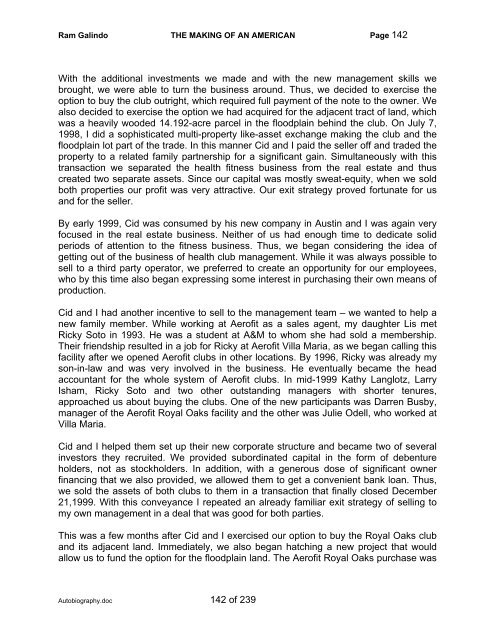Autobiography - The Galindo Group
Autobiography - The Galindo Group
Autobiography - The Galindo Group
Create successful ePaper yourself
Turn your PDF publications into a flip-book with our unique Google optimized e-Paper software.
Ram <strong>Galindo</strong> THE MAKING OF AN AMERICAN Page 142<br />
With the additional investments we made and with the new management skills we<br />
brought, we were able to turn the business around. Thus, we decided to exercise the<br />
option to buy the club outright, which required full payment of the note to the owner. We<br />
also decided to exercise the option we had acquired for the adjacent tract of land, which<br />
was a heavily wooded 14.192-acre parcel in the floodplain behind the club. On July 7,<br />
1998, I did a sophisticated multi-property like-asset exchange making the club and the<br />
floodplain lot part of the trade. In this manner Cid and I paid the seller off and traded the<br />
property to a related family partnership for a significant gain. Simultaneously with this<br />
transaction we separated the health fitness business from the real estate and thus<br />
created two separate assets. Since our capital was mostly sweat-equity, when we sold<br />
both properties our profit was very attractive. Our exit strategy proved fortunate for us<br />
and for the seller.<br />
By early 1999, Cid was consumed by his new company in Austin and I was again very<br />
focused in the real estate business. Neither of us had enough time to dedicate solid<br />
periods of attention to the fitness business. Thus, we began considering the idea of<br />
getting out of the business of health club management. While it was always possible to<br />
sell to a third party operator, we preferred to create an opportunity for our employees,<br />
who by this time also began expressing some interest in purchasing their own means of<br />
production.<br />
Cid and I had another incentive to sell to the management team – we wanted to help a<br />
new family member. While working at Aerofit as a sales agent, my daughter Lis met<br />
Ricky Soto in 1993. He was a student at A&M to whom she had sold a membership.<br />
<strong>The</strong>ir friendship resulted in a job for Ricky at Aerofit Villa Maria, as we began calling this<br />
facility after we opened Aerofit clubs in other locations. By 1996, Ricky was already my<br />
son-in-law and was very involved in the business. He eventually became the head<br />
accountant for the whole system of Aerofit clubs. In mid-1999 Kathy Langlotz, Larry<br />
Isham, Ricky Soto and two other outstanding managers with shorter tenures,<br />
approached us about buying the clubs. One of the new participants was Darren Busby,<br />
manager of the Aerofit Royal Oaks facility and the other was Julie Odell, who worked at<br />
Villa Maria.<br />
Cid and I helped them set up their new corporate structure and became two of several<br />
investors they recruited. We provided subordinated capital in the form of debenture<br />
holders, not as stockholders. In addition, with a generous dose of significant owner<br />
financing that we also provided, we allowed them to get a convenient bank loan. Thus,<br />
we sold the assets of both clubs to them in a transaction that finally closed December<br />
21,1999. With this conveyance I repeated an already familiar exit strategy of selling to<br />
my own management in a deal that was good for both parties.<br />
This was a few months after Cid and I exercised our option to buy the Royal Oaks club<br />
and its adjacent land. Immediately, we also began hatching a new project that would<br />
allow us to fund the option for the floodplain land. <strong>The</strong> Aerofit Royal Oaks purchase was<br />
<strong>Autobiography</strong>.doc 142 of 239


